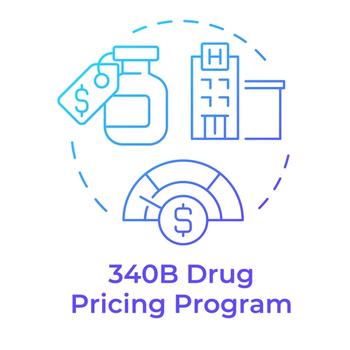
Specialty Drugs Driving Increase in Hospital Pharmacy Spend
Carina Dolan, Pharm.D., talks about the trends that are driving both the acute and non-acute spending in hospitals for the next year.
Hospital pharmaceutical drug prices are projected to increase 3.42% beginning in January 2024, according to Vizient’s new
The spend in specialty drugs and high-cost therapies is growing, especially in the ambulatory setting, Carina Dolan, Pharm.D., associate vice president, clinical oncology, pharmacoeconomics and market insights, at Vizient, said in an interview.
Vizient predicts inpatient drug spend will increase just 2% while outpatient growth in pharmacy spend is expected rise 16%. This growth is expected to be in behavioral health, cardiovascular, neuroscience, and oncology. Offsetting this growth is the continued uptake of biosimilars, which has increased over the last few years.
Biosimilars are having a positive impact on spending, Dolan said. “They do provide a cost savings for members and for patients,” she said. “Biosimilars across the board do save hospitals money because they are less expensive products then a brand product. That, in turn, means a lower cost to patients. The point of biosimilars is access to care and access to drugs.”
Biosimilars account for nearly 25% of spend overall compared with their originator products, among Vizient clients. Currently, there are 40 approved biosimilars with projected savings of $181 billion over the next five years, reaching across multiple services lines, according to the Center for Biosimilars. In oncology, three biosimilar monoclonal antibodies that launched in 2019 – Avastin (bevacizumab), Herceptin (trastuzumab), and Rituxan (rituximab) – have seen a significant uptake in the market.
Within the autoimmune and inflammatory diseases category, pharmacy spend among Vizient clients is accelerating. Vizient predicts this category to experience a 3.68% in inflation rate and be 20.56% of total drug spend. Among Vizient pharmacy program participants, Amgen’s Humira (adalimumab) and Stelara (ustekinumab) are the top drugs with the highest spend both in the autoimmune category and among all medications.
The report indicates that biosimilars of Humira — which is used to treat several immune conditions, including rheumatoid arthritis, psoriatic arthritis, Crohn’s disease and ulcerative colitis. “But since Humira is generally prescribed on the outpatient side, the payers will determine update of the biosimilars,” Dolan said.
The report suggest that it could be six to 12 months to see an impact from the new Humira biosimilars as hospital formularies begin to assess the various options. There are now eight Humira biosimilars on the market, with various pricing options.
Some insurers and PBMs — such as Express Scripts and Optum Rx — say the biosimilars will have parity with Humira. A few have indicated they are preferring the biosimilars. For example, Kaiser Permanente has said it has switched almost 90% of its members to Amgen’s Amjevita and expects to save $300 million.
“Everyone is watching this to see how it will play out,” Dolan said. “The next Pharmacy Market Outlook will continue to watch that, and we probably will have more talk next year.”
Next year, Vizient predicts Stelara will be the top drug by size of increase, but biosimilars for Stelara aren’t expected to reach the market until 2025. Stelara is administered first with an IV infusion and then followed by self-administration for Crohn’s and ulcerative colitis, but by self-administration for psoriasis and psoriatic arthritis. Vizient said in its report that with Stelara, and other use high utilization products, even a small price increase can result in changes in pharmacy budgets. This will an impact on both the acute and non-acute hospital spending.
Another impact on hospital budgets has been increased drug shortages, which hit a high in the first quarter of 2023. Cancer drugs have been impacted as well, and shortages have been widespread. In fact, 93% of cancer centers have faced shortages of carboplatin and cisplatin, according to a survey by the National Comprehensive Cancer Network. Carboplatin is used to treat patients with ovarian cancer; cisplatin is used to treat advanced ovarian cancer, testicular cancer, and bladder carcinoma. Shortages are also impacting supplies of other cancer drugs, including docetaxel, fludarabine, fluorouracil and methotrexate.
“Since our members span acute and non-acute care, our members see the drug shortages,” Dolan said. “The oncology drugs are especially difficult because they are foundational to how we treat many of the disease states today.”
She pointed to several resources to assist Vizient members with drug shortages, including mitigation strategies and the Novaplus Enhanced Supply (NES) program, which is a list of contracted suppliers that have assured supply of drugs for participating Vizient members. Additionally, Vizient established the End Drug Shortages Alliance. The nonprofit launched in 2022 with the mission of solving pharmaceutical supply challenges faced by healthcare organizations and other stakeholders. Vizient also provides drug shortage alerts.
Oncology is an area of rapid growth with high utilization, especially of the immunotherapy checkpoint inhibitors such as Keytruda (pembrolizumab), Opdivo (nivolumab), Imfinzi (durvalumab) and Yervoy (ipilimumab). Projected inflation of all oncology products is 3.67%, accounting for 22.47% of drug spend, according to the Vizient report. In addition, the Impact of Change report by Sg2 Analytics, a Vizient company, projects 14% increase in the outpatient setting in part due to the use of combination therapies.
CAR-T therapies that treat multiple myeloma, several lymphomas and acute lymphocytic leukemia, are also contributing to spend because of their high costs. These therapies have prices that start at $424,000 per infusion.
Newsletter
Get the latest industry news, event updates, and more from Managed healthcare Executive.




















































